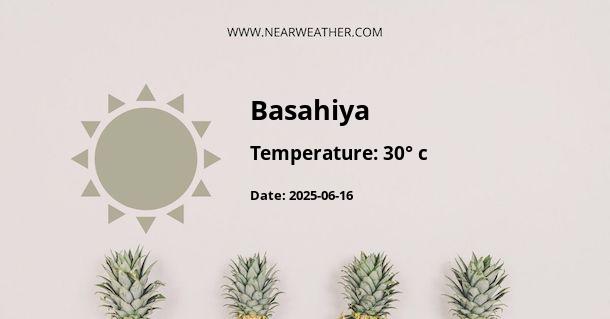Climate and Weather in Basahiya, Nepal
Basahiya, located in the southeastern part of Nepal, experiences a subtropical climate marked by distinct seasons throughout the year. The region's weather is heavily influenced by its geographical location, with the Terai plains to the south and the Mahabharat Range to the north playing a significant role in shaping its climate. Understanding the year-round weather patterns in Basahiya is crucial for residents, tourists, and businesses operating in the area.Seasonal Weather Patterns
| Month | Minimum Temperature (°C) | Maximum Temperature (°C) |
|---|---|---|
| January | 7 | 20 |
| February | 9 | 24 |
| March | 13 | 28 |
| April | 18 | 32 |
| May | 21 | 33 |
| June | 24 | 33 |
| July | 25 | 31 |
| August | 25 | 32 |
| September | 24 | 32 |
| October | 18 | 31 |
| November | 11 | 27 |
| December | 8 | 22 |
The climate in Basahiya can be classified into four distinct seasons based on temperature and rainfall:
1. Winter (December-February): The winter months are relatively dry and cool, with temperatures ranging from 7°C to 24°C. This period may experience fog and mist in the mornings, especially in lower-lying areas. 2. Spring (March-May): Spring brings warmer temperatures, with average highs reaching 33°C in May. This season also marks the beginning of the pre-monsoon showers, which contribute to the region's lush vegetation and agricultural activities. 3. Summer (June-August): The summer months in Basahiya are characterized by hot and humid weather, with temperatures reaching up to 33°C. This period also experiences the majority of the annual rainfall, contributing to the region's vital water sources. 4. Autumn (September-November): Autumn sees a gradual decrease in temperature and humidity, making it a popular time for outdoor activities and tourism. The weather is generally clear and pleasant, with temperatures ranging from 27°C to 32°C.Rainfall Patterns
Basahiya experiences a monsoonal climate, with the majority of its annual rainfall occurring during the monsoon season from June to September. The table below highlights the average monthly precipitation in Basahiya:
| Month | Precipitation (mm) |
|---|---|
| January | 14 |
| February | 18 |
| March | 35 |
| April | 81 |
| May | 214 |
| June | 377 |
| July | 575 |
| August | 496 |
| September | 327 |
| October | 85 |
| November | 16 |
| December | 5 |
The monsoon season, lasting from June to September, brings the heaviest rainfall to Basahiya, with July and August receiving the highest precipitation. This period is crucial for agriculture and contributes significantly to the region's biodiversity and ecosystem.
Natural Disasters and Climate Risks
Despite its favorable climate, Basahiya is susceptible to natural disasters such as floods, landslides, and occasional droughts. The combination of heavy monsoon rainfall and the region's topography can lead to flooding in low-lying areas, posing a risk to both human settlements and agriculture. Additionally, the potential for landslides increases during the monsoon season, especially in steep terrain.
Conclusion
Understanding the climate and weather patterns in Basahiya, Nepal, is essential for residents, businesses, and travelers alike. The region's subtropical climate brings distinct seasonal variations, with the monsoon season playing a crucial role in sustaining the local ecosystem and agricultural activities. While the climate offers opportunities for agriculture and tourism, it is essential to remain vigilant during natural disaster-prone periods to ensure the safety and well-being of the community.
A - Basahiya's Latitude is 26.696100 & Longitude is 85.911797.
A - Weather in Basahiya is 28° today.
A - Climate Conditions in Basahiya shows overcast clouds today.
A - Humidity in Basahiya is 81% today.
A - Wind speed in Basahiya is 7.42 km/h, flowing at 100° wind direction. today.
